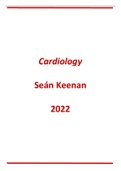Summary
Summary Cardiology Notes
- Course
- Institution
Cardiology notes summarising all cardiac disorders required for clinical studies in medical school. Investigations and managements based on UK guidance. Look at specialty section and content list for the summary contents of this file.
[Show more]



